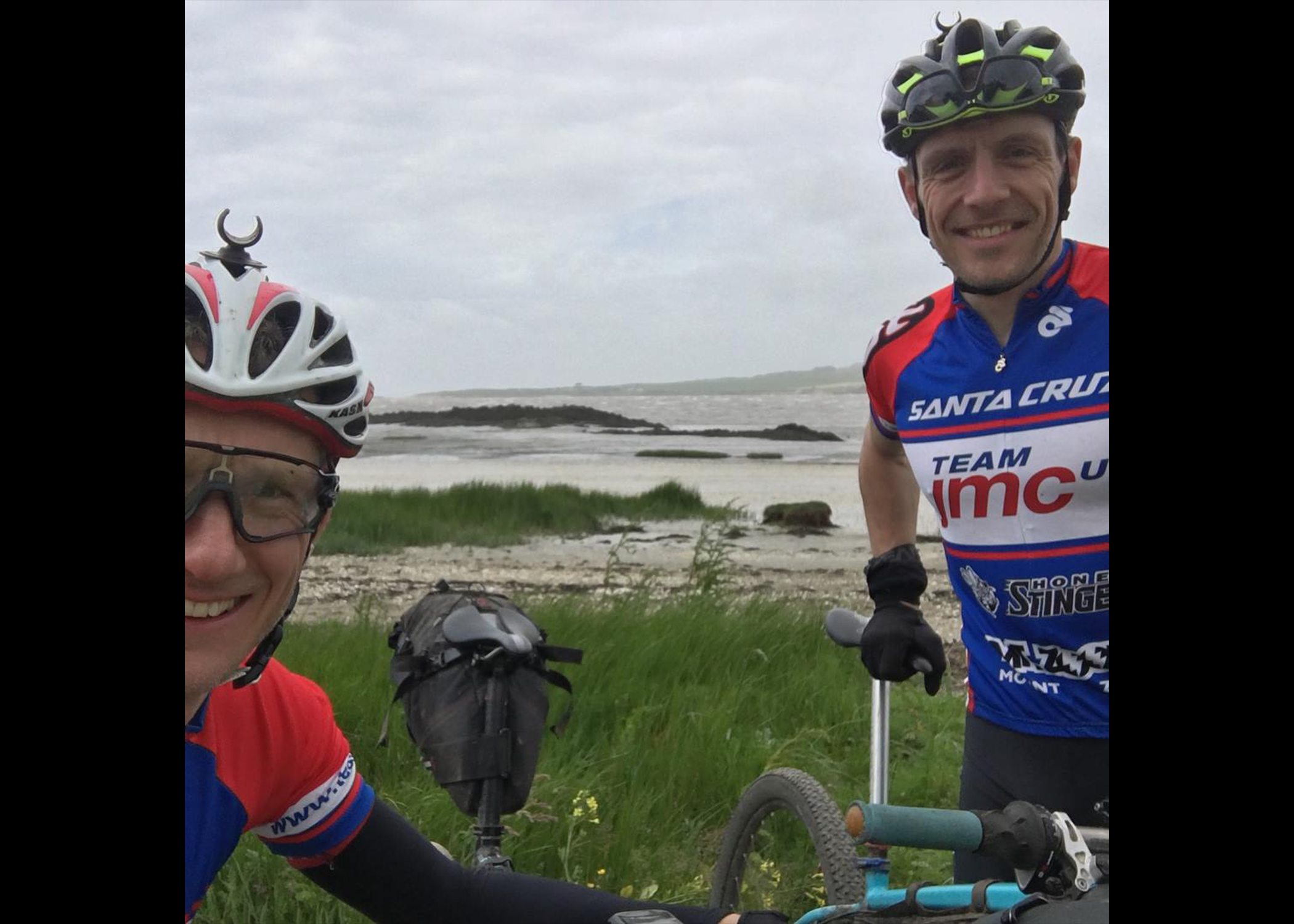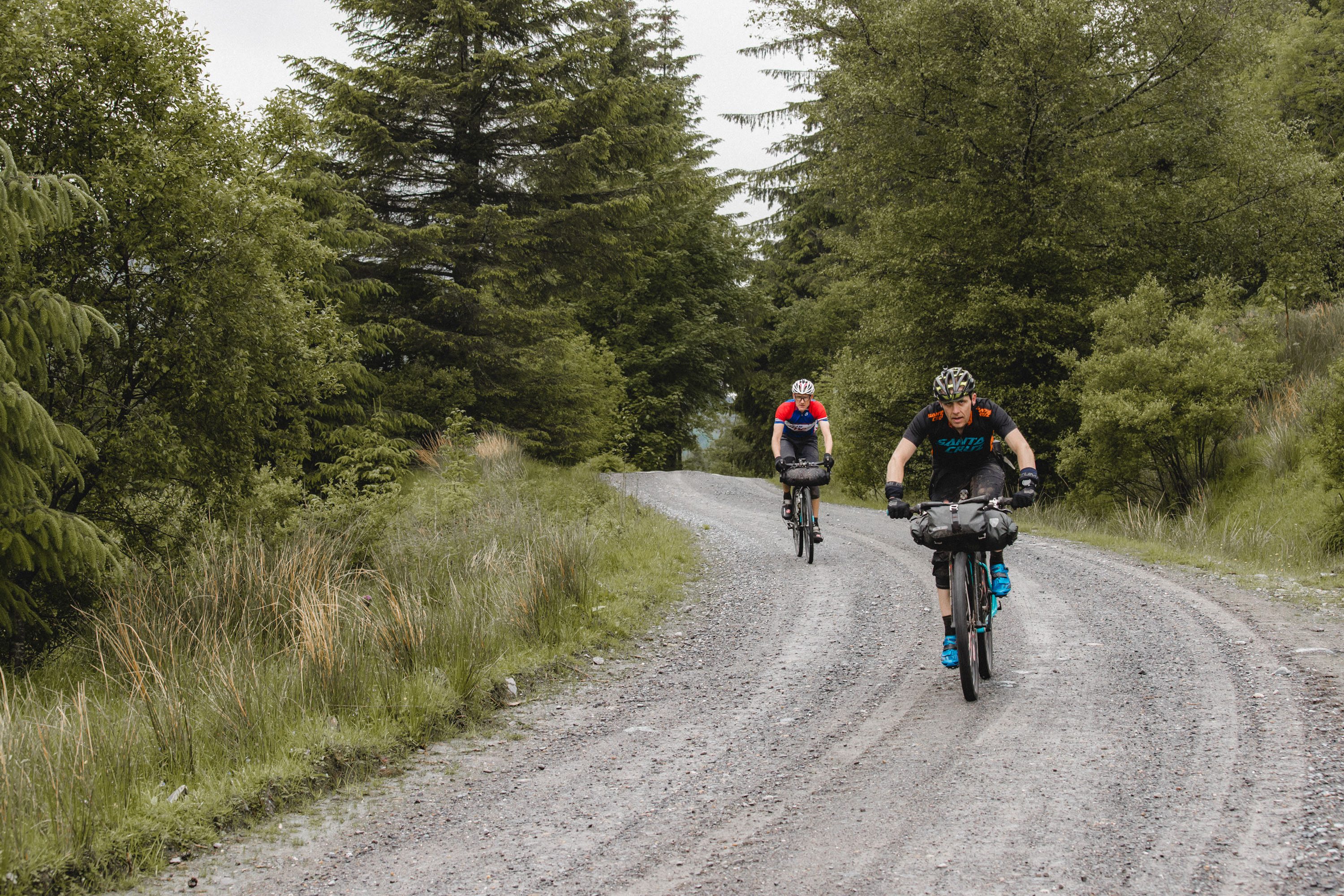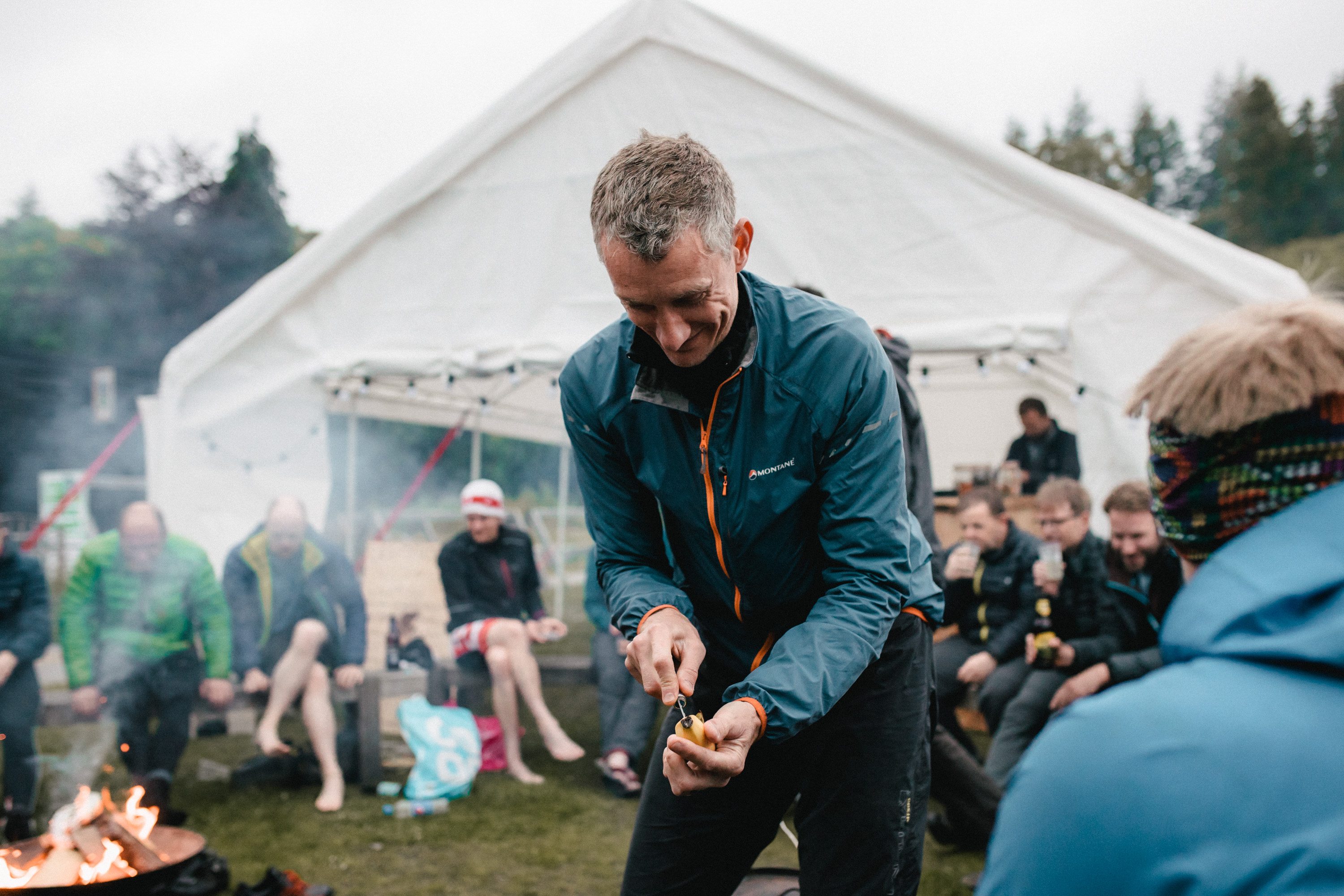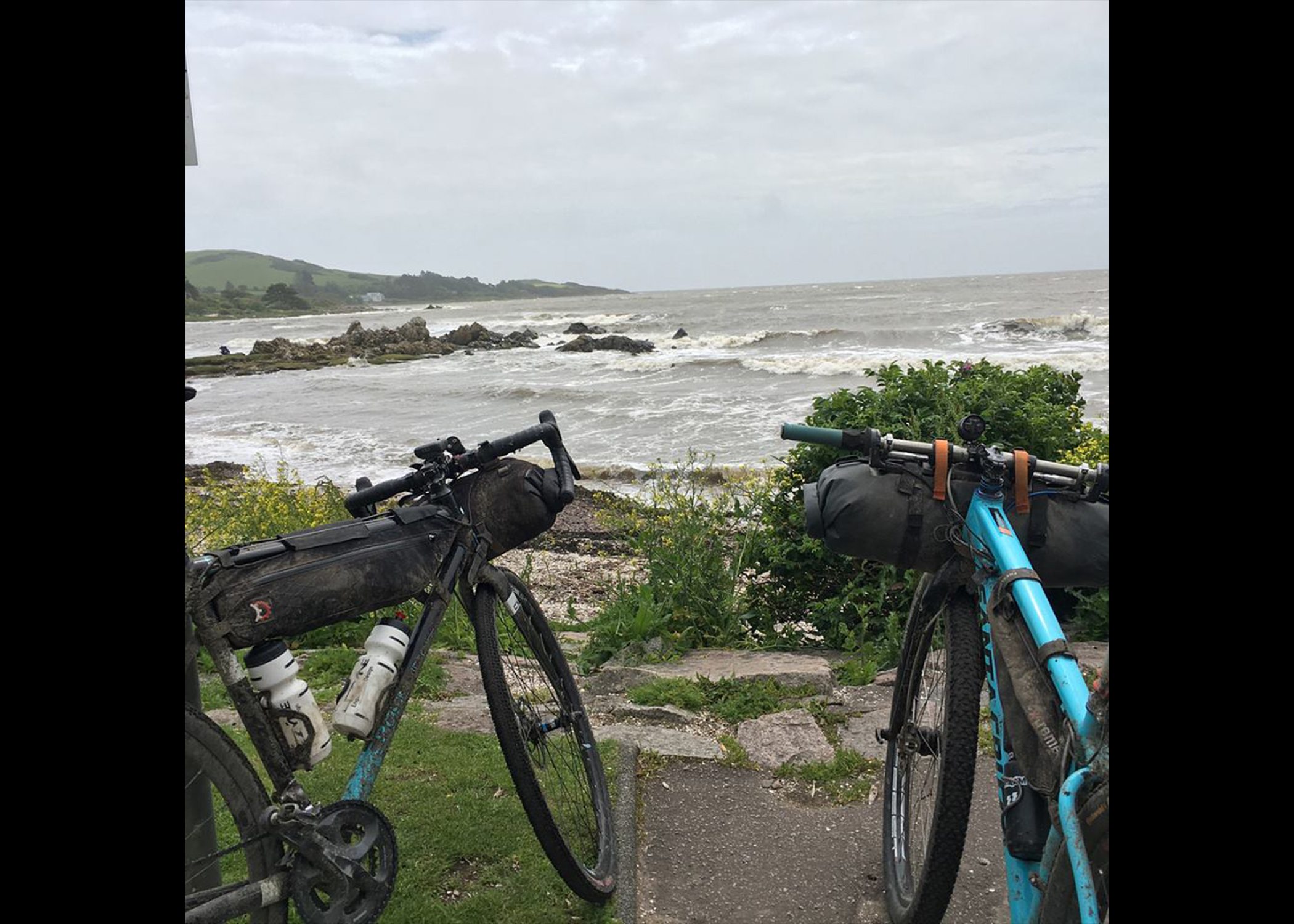It takes some doing, getting out of a family weekend away to spend that time riding bikes and living like a homeless person in the Galloway Hills in Scotland with your mates instead. But when you’re a lad as cunning as my mate Phil Simcock, no problem is insurmountable.
I’d already resigned myself to the fact that I’d be riding The Distance—a two-day, ‘unsupported with benefits’ bikepacking event—on my own. Well, not on my own, but not with anyone I knew particularly well. But somehow Phil wangled a pass and persuaded his long-suffering wife that disappearing for two days, rather than going camping with his family and friends, was in fact the Right Thing To Do.
I suspect he’s spent all of his spare time decorating or putting up shelves ever since, but never mind.

Driving to a remote, deserted car park after work on Friday evening has over the years become a fairly normal pastime for both of us, as I’m sure it is for several of those reading this. Purely for cycling-related reasons rather than anything deviant, mind.
“No overnight camping” said the sign at the car park near Colvend Public Hall, which was to be the staging area of tomorrow’s event. It was also next door to a nice café that was opening early to serve coffee and bacon.
It was dark when we arrived, so we only noticed the sign in the morning, as Phil emerged from his tent and I fell out of the back of the car, trying to escape from my bivvy bag. We weren’t the only ones breaking the strict laws of the Parish Council either, as several other bleary-eyed cyclists emerged from vans and cars and commenced the pre-ride faff. The duration and complexity of pre-ride faffing is often proportionate to the duration of the actual ride you’re about to do, so a two-day ride with an overnight camp in a mystery location involves some industrial-strength faffing.
All the other riders had left by the time Phil and I left the car and started the ride to the actual start line, about half a mile away. As The Distance isn’t a race, the start time was quite relaxed: “between 8am and 9am,” according to the briefing. It was raining, so we set off right at the last minute, but then discovered that everyone had already left about half an hour ago.
Far from being a ‘standard’ bikepacking event, The Distance—organised by Focal Events (also responsible for the competitive, and very hard, Dirty Reiver gravel race) and backed by Kinesis, WTB, Blackburn and Brooks—has some novel twists. First off, nobody knows what the route is until the ride starts, and even then, only the first part of the route is revealed. Day 1 is split into four segments, and apart from the first one, each segment has two distance options. Which one of those that you do is largely determined by how long it takes you to do the previous segment, the aim being that all riders—fast and not-so-fast—arrive at the overnight camp location at around the same time.
Riders could also opt to ride the shorter of the two options at each checkpoint if they were starting to feel tired, which is a sensible move on the part of the organisers.
Both very much intending to make the most of the weekend, Phil and I got cracking and rode as fast as we could to try to make up some time on those riders in front of us. Navigation was straightforward enough as we had maps and GPX files, and we could follow tyre tracks in the (sometimes quite muddy) ground in front of us.
Deserted minor roads and wide gravel tracks led to narrow singletrack trails, revealing dramatic hillsides and valleys in an area of the country that seems to be barely visited by, well, anyone really. Most of the mountain bikers who come to southern Scotland probably stick to the safe options of the 7Stanes trails, and quite honestly, we didn’t see anyone else for hours on end. No cars, cyclists, walkers…nobody. Plenty of sheep and cows and the odd shepherd on a quad bike, but not much in the way of other people.

For me, it was a particularly exciting ride because I’m moving to Dumfries and Galloway from Manchester later this year, so I was keen to make mental notes of all the best bits.
To be fair, the entire ride was just one long ‘best bit.’ The highlight for me, though, was the long climb to Clatteringshaws Loch and the wide gravel trail beyond—the incredible descent down to Glentrool with a deep valley on one side and a glen (which wouldn’t look out of place in The Highlands) on the other were truly eye-popping. Oh, and the extended café stop in Kirkcudbright. That was pretty good, too.
Along the way, riders needed to fill in their brevet cards. A traditional way to verify that a rider has completed a given route, The Distance’s brevet card asked the rider questions that could only be answered if they’d visited a certain spot, and unless you had an encyclopaedic knowledge of the area, you’d have to ride the whole route to ascertain the answer. “How many steps up the tower?”, for example.
Climbing a spiral of steep, wet stone steps up a medieval tower in carbon-soled cycling shoes wasn’t what I was expecting to be doing this weekend, but rules are rules…
At the final checkpoint we met up with some other riders who were in the middle of the short-or-long debate. We were fully committed still to the long option (what else were we going to do?), but first we diverted off the route to pop into nearby Newton Stewart to buy some midge spray (I knew I’d forgotten something) and so that I could show off my soon-to-be new house. A quick visit to the petrol station for a can of Cream Soda to get us through the next 25K of riding and we were off.
Soon we realised that the overnight camp would be at the brilliant Forestry Commission visitor centre at Kirroughtree Forest—home to arguably the best man-made mountain bike trails in the country, a great café, and an equally good bike shop, The Break Pad.
Organisers Paul Errington and Andy Williamson had arranged a nice field for camping, a campfire, and a gin bar to welcome riders—some of whom had been riding for most of the day and had covered over 100 miles and ascended around 8000 feet.

Campfire antics went well into the night, and thankfully the rain that hammered down at the start of the event didn’t make a reappearance.
In the morning, the obligatory “Did you manage to get any sleep at all?” conversations took place over big breakfasts in the café, while other riders hurriedly re-packed bivvy bags into various bike-mounted luggage.
Knowing that we both should get moving and make a return to our real lives, I started to race Phil to the end of breakfast. Somehow neither of us suffered with indigestion as we set off on our route back to the start in Colvend. This time the route was shorter at 50 or so miles and would mostly be on roads.
Again, the roads were largely empty, apart from another visit to Kirkcudbright and an accidental blunder into the middle of a village fun run (whoops). The highpoint this time was a coastal trail south of Gatehouse of Fleet which was remote and beautiful in equal measure. More mental notes were made…
A small detour along the blue-graded mountain bike trail in Dalbeattie forest rounded off the ride back to the car, luckily parked just down the road from an ice cream van.
The Distance was a brilliant way to spend a weekend riding in an unfamiliar part of the UK. The concept provides a perfect introduction to the world of bikepacking, with others looking out for your welfare and without the perceived risks of getting lost. This might upset some of the bikepacking purists out there, but getting out in the hills on pushbikes is for everyone, right?

After the event, organiser Andy Williamson found time to speak to me about The Distance and its future…
Grit.cx: Who is Andy Williamson? Have you got a day job or are you a full-time event organiser?
AW: Escapee teacher of 20+ years. Now I spend my days organising three young kids, and as director of Focal Events, organising a host of varied cycle-based events.
Grit.cx: How did all this begin? Straight into The Distance or do you have a long history in organising races and events?
AW: I’ve organised MTBO/Trailquest events for a while, and a couple of years ago, joined Bryan in organising some road sportives and then the Kielder 101. In 2016, we delivered the Dirty Reiver 200 route with Paul [Errington], and off the back of that, the three of us formed Focal Events—on ‘Brexit Day’ last June…
I’m a map geek, so it allows me to stare at OS maps and search the internet for images of possible trails, while pretending it’s work.
Between the three of us we have a lot of event riding experience and we have channelled this to deliver rider-focused events big on experience. Though our initial event was the Dirty Reiver, a single-day single-lap [event], we all have personal interest in bikepacking. We figured there’d be a lot of people who fancied giving bikepacking a go, but would be happier if given a route to ride and had some facilities/comfort to head for. We’ve already had feedback from riders saying that The Distance has given them confidence to get out and do more, so there’s a win.
Grit.cx: How much of a challenge is it to organise events in remote parts of the UK? Or is it actually the same as organising a 60-minute race around the local park?
AW: It really depends on the area in question. In remote areas you have to be able to assess the risks fairly confidently. If you are releasing a hundred riders into the hills, where there are no communications, shops, buildings etc., then you need to be prepared if the weather turns nasty. I’ve visited Galloway frequently since I was a wee’n, so knew it fairly well. The people up there are generally super friendly and only too keen to see more visitors.
Checking trails is obviously a big challenge, especially as winter storms change them constantly. Having the experience to judge hazards from the perspective of a tired rider is key to making sure it’s safe (or safe enough). We’re qualified MTB Leaders which helps here.
Another element is trying to talk to all the landowners/locals that might be affected by an event—we have always tried to engage with those who could be affected as early as possible to save any issues later. One of the key landowners for The Distance sold up and moved on in May, so we’d some quick re-negotiation to do.
One aspect of The Distance we didn’t expect was that many more riders were using solely the maps with no access to a GPS unit. In the future we will produce a more comprehensive set of maps for those who like the more involved approach.
Grit.cx: Do the authorities (the Forestry Commission, etc.) in Scotland welcome and embrace The Distance or is it merely tolerated?
AW: They welcome events, and the FC folk in Galloway are some of the best we’ve worked with. They were clearing windblown trees and checking stuff for us in the run-up to The Distance.
The tourist authorities up there are keen too, especially Visit South West Scotland, who are a relatively new organisation but with plans to develop the huge outdoor resource they have.
Grit.cx: What’s your favourite aspect of organising events such as this?
AW: Meeting new folks—riders, landowners, sponsors, etc. The map geekery is great, too, but event organising connects you with a huge range of different folk. In teaching you tend to just meet teachers…
The range of riders and bikes was interesting, too, from your usual weekend eventers, to endurance racers and ‘Brompton touring gentlemen of advanced years.’ There were mountain bikes, CX bikes, homemade frames, and of course the box-fresh Kinesis Tripster ATR’s. The challenge for us was to get all of these different riders to the same place after eight or nine hours riding over varied distances. On the whole the concept worked really well, with the usual tail-enders finishing ahead of the faster guys, so in good time to enjoy the overnight experience.
At Focal, our main focuses are that the riding is great and that the experience is second to none. We aim to make the social side a highlight, and our event partners like Craft Distillery and Pannier.cc help to make this happen. We aim for riders to travel home feeling that they’ve been part of a shared experience.
Grit.cx: What of the future? Keeping things relatively low-key or are there ambitions to make The Distance bigger and/or longer?
AW: This year our aim was just to prove the concept and successfully run this style of event. We learned a lot from the weekend and the plan is to grow the event. Our plan is to run it again in Galloway next year, but also to have a couple of other venues/areas lined up, so that the challenge is fresh for returning riders. Folk seemed to enjoy the mix of riding, and the tarmac sections allowed some reprieve, often offering a great view. In future, there’s the option to have more mountain bike-oriented routes or to allow riders to choose sections suited to the bike they’re on, or their experience. We think there’s demand for an event that allows people to push themselves, on a self-supported challenge with an element of uncertainty/adventure—but safe in the knowledge that there’s a hot meal and some comfort at the end.


